Middle Paleolithic Neanderthal Open-Air Camp and Hyena Den Westeregeln (D)—Competition for Prey in a Mammoth Steppe Environment of Northern Germany (Central Europe)
Abstract
1. Introduction
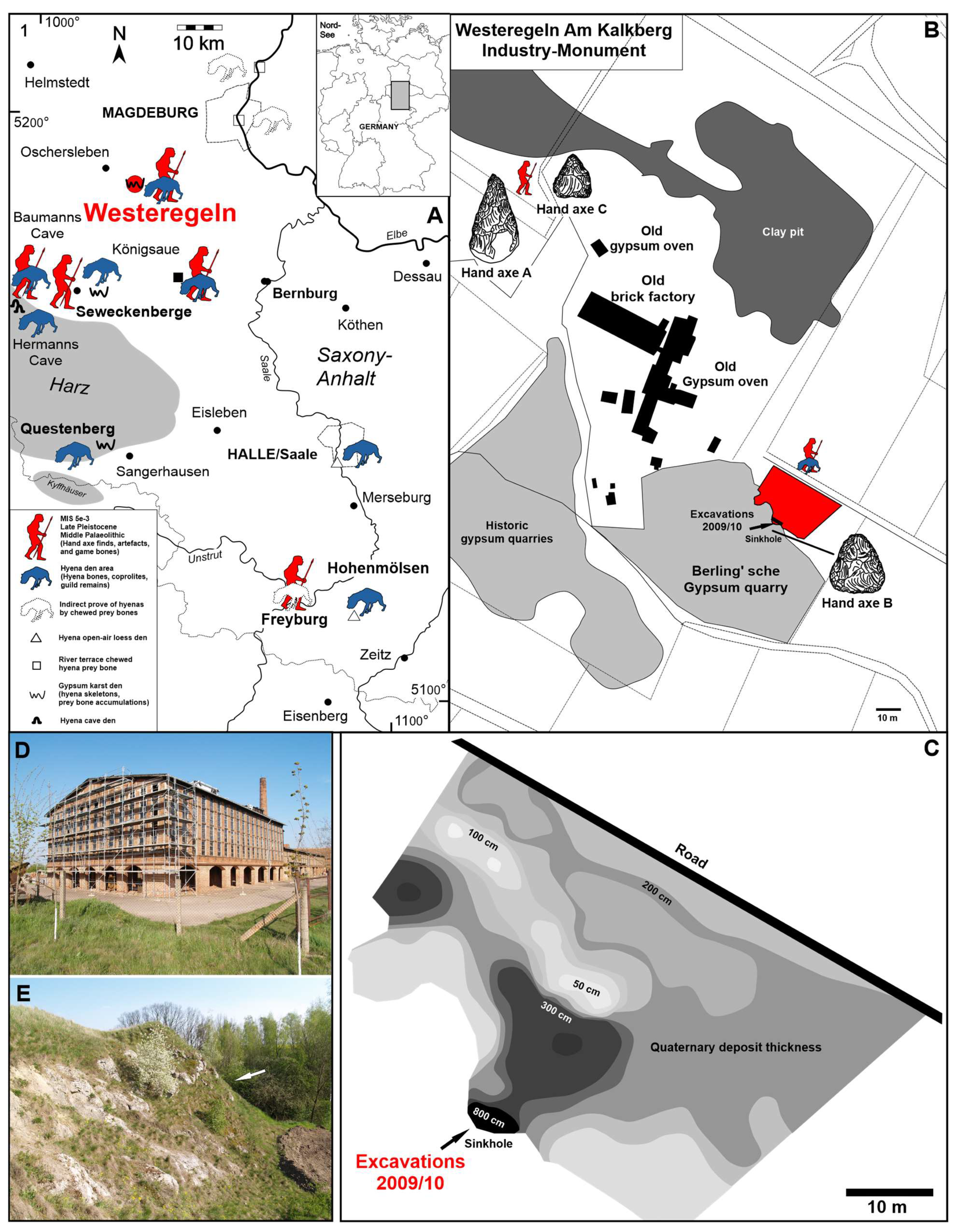
2. Materials and Methods

Excavation Surfaces (=Plana)
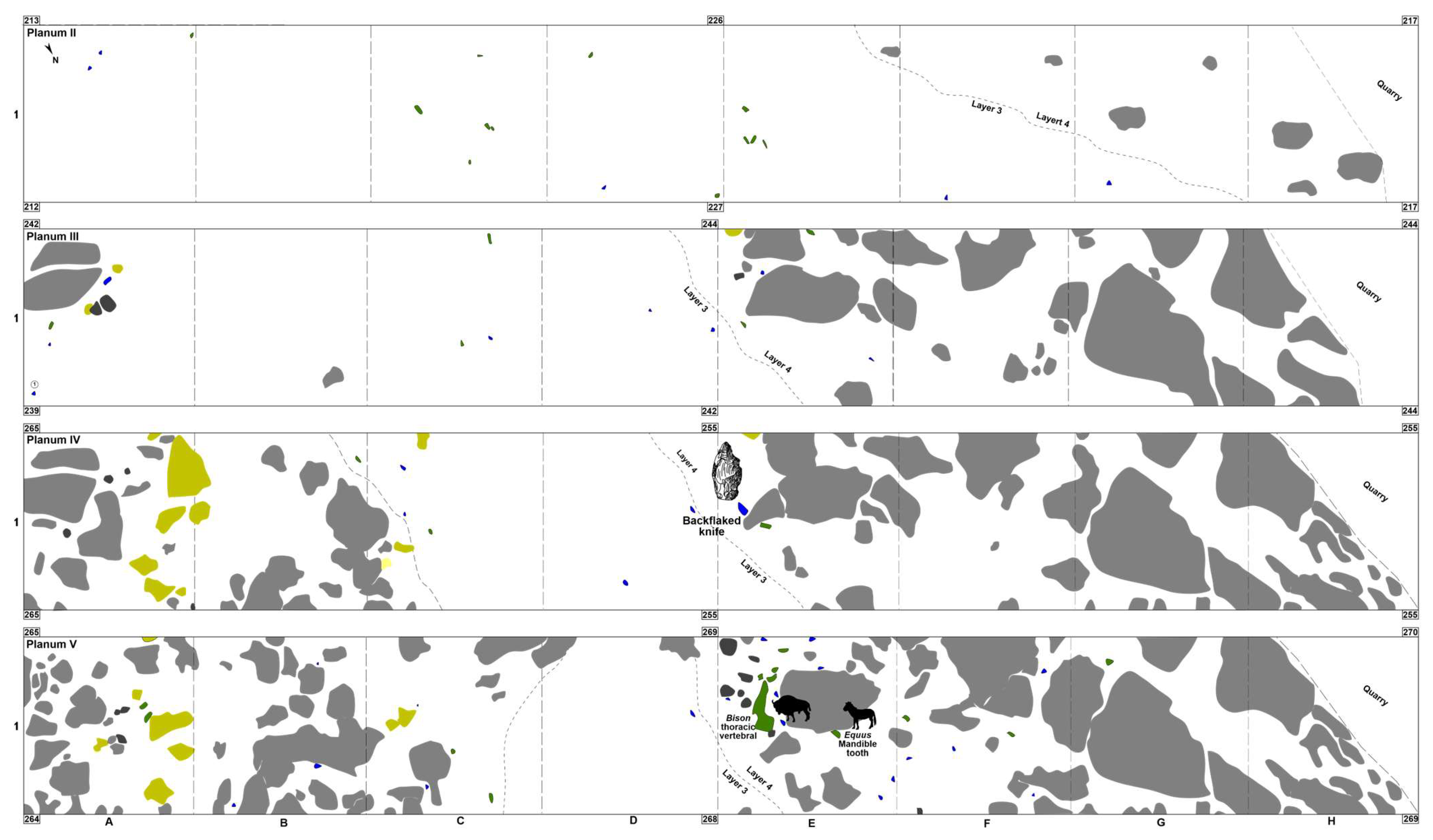



3. Geology
3.1. Gypsum Karst Sinkholes

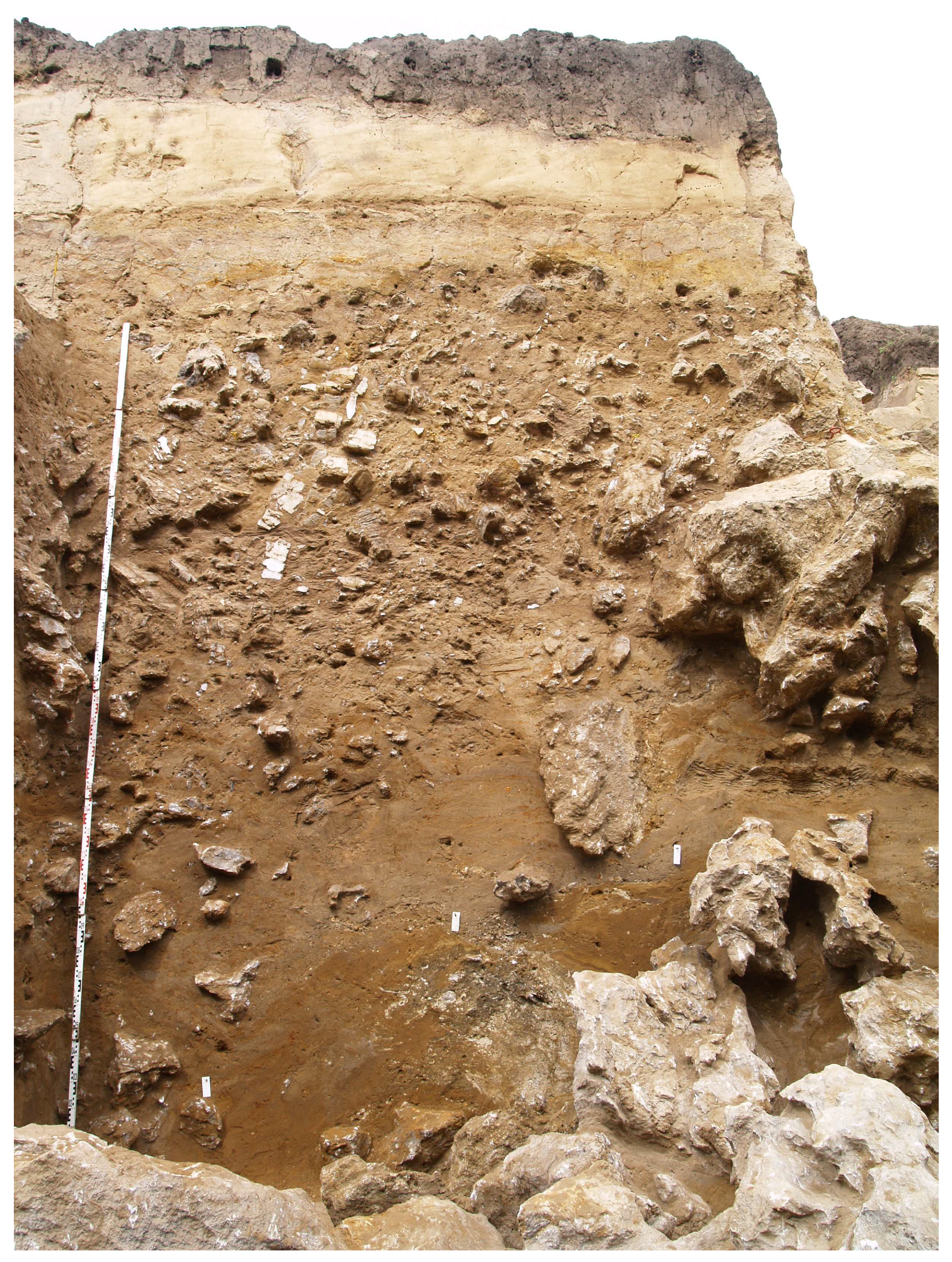


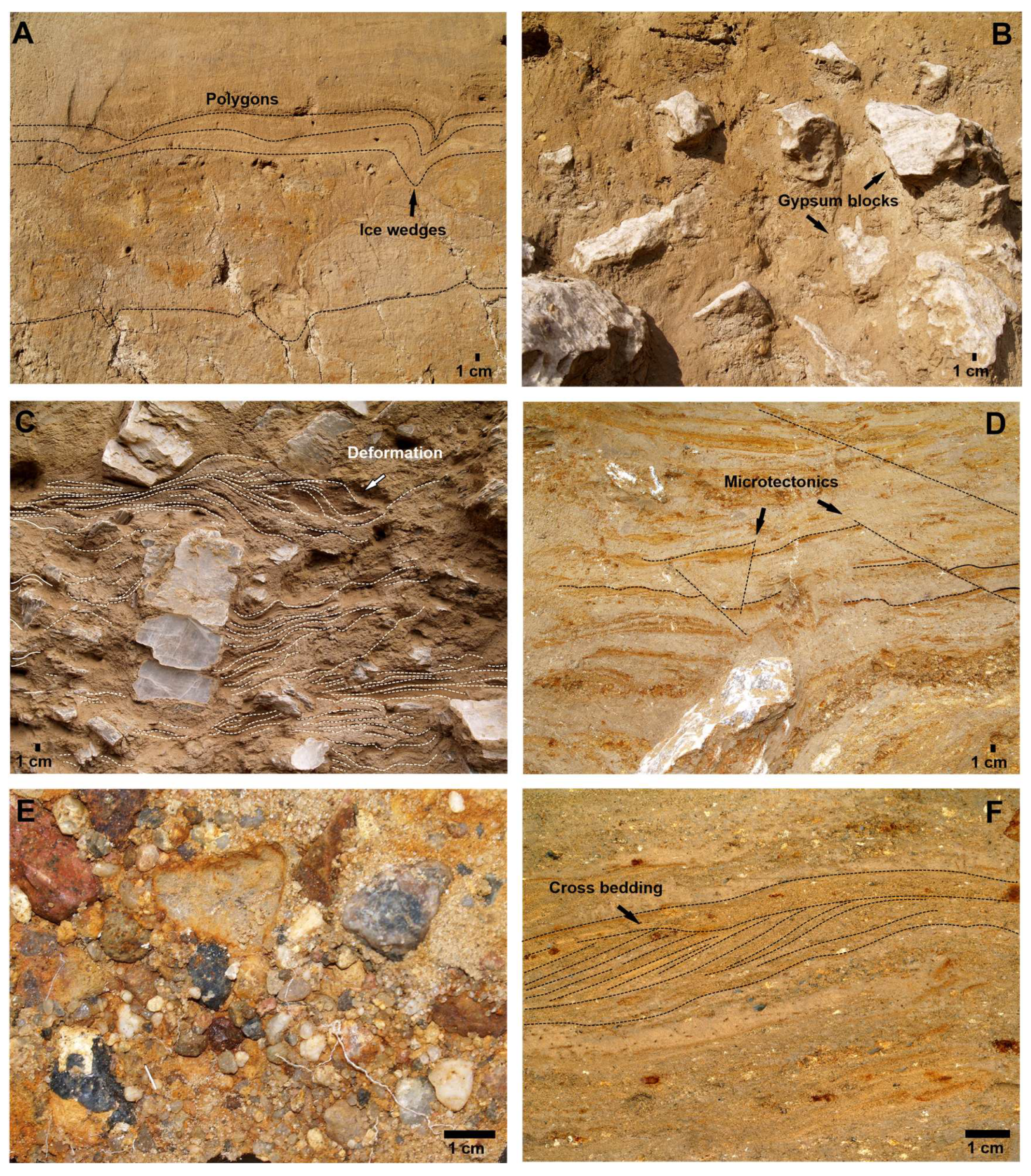
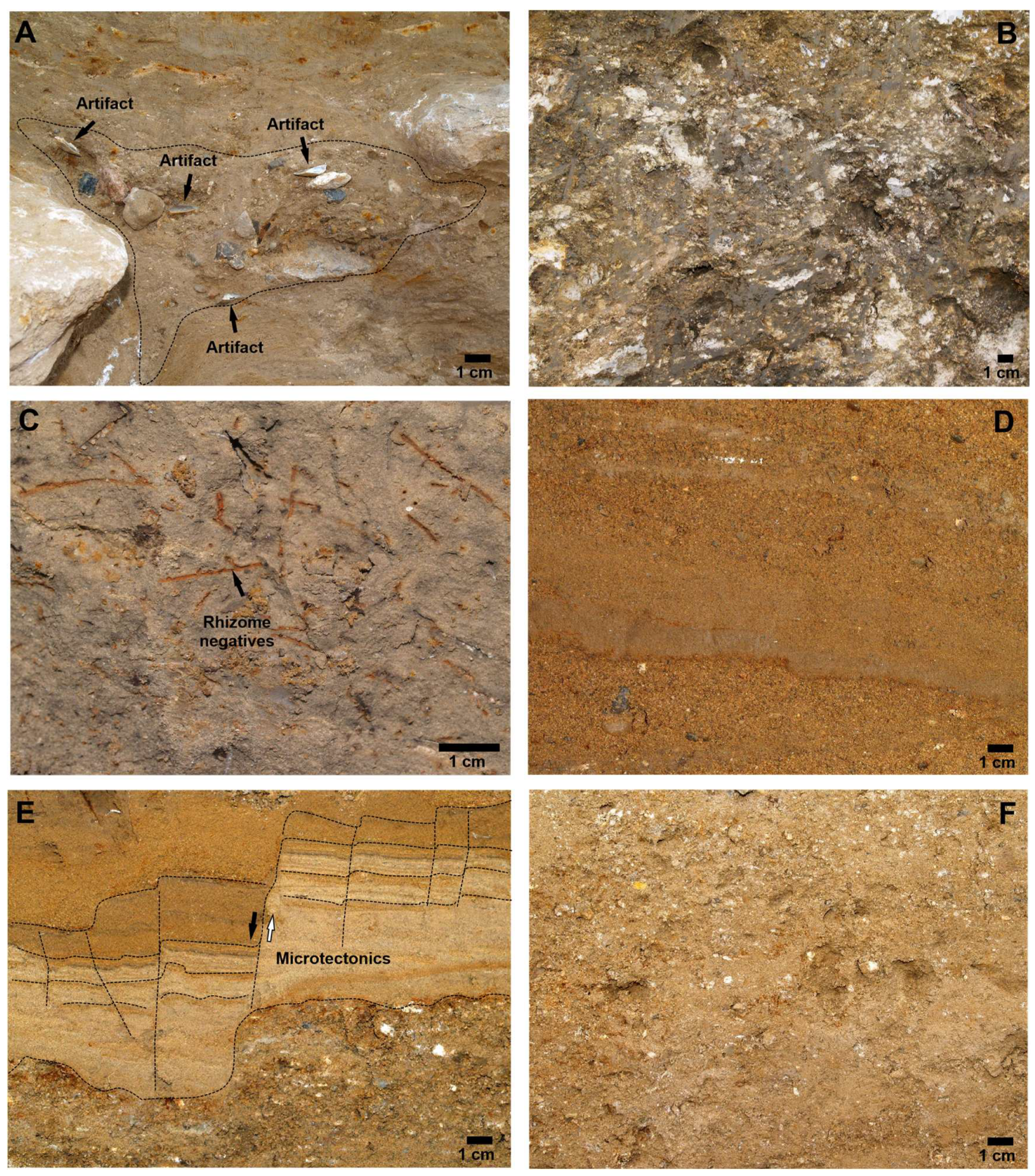
3.2. Stratigraphy, Sedimentology, Dating, and Bone/Artifact Taphonomy
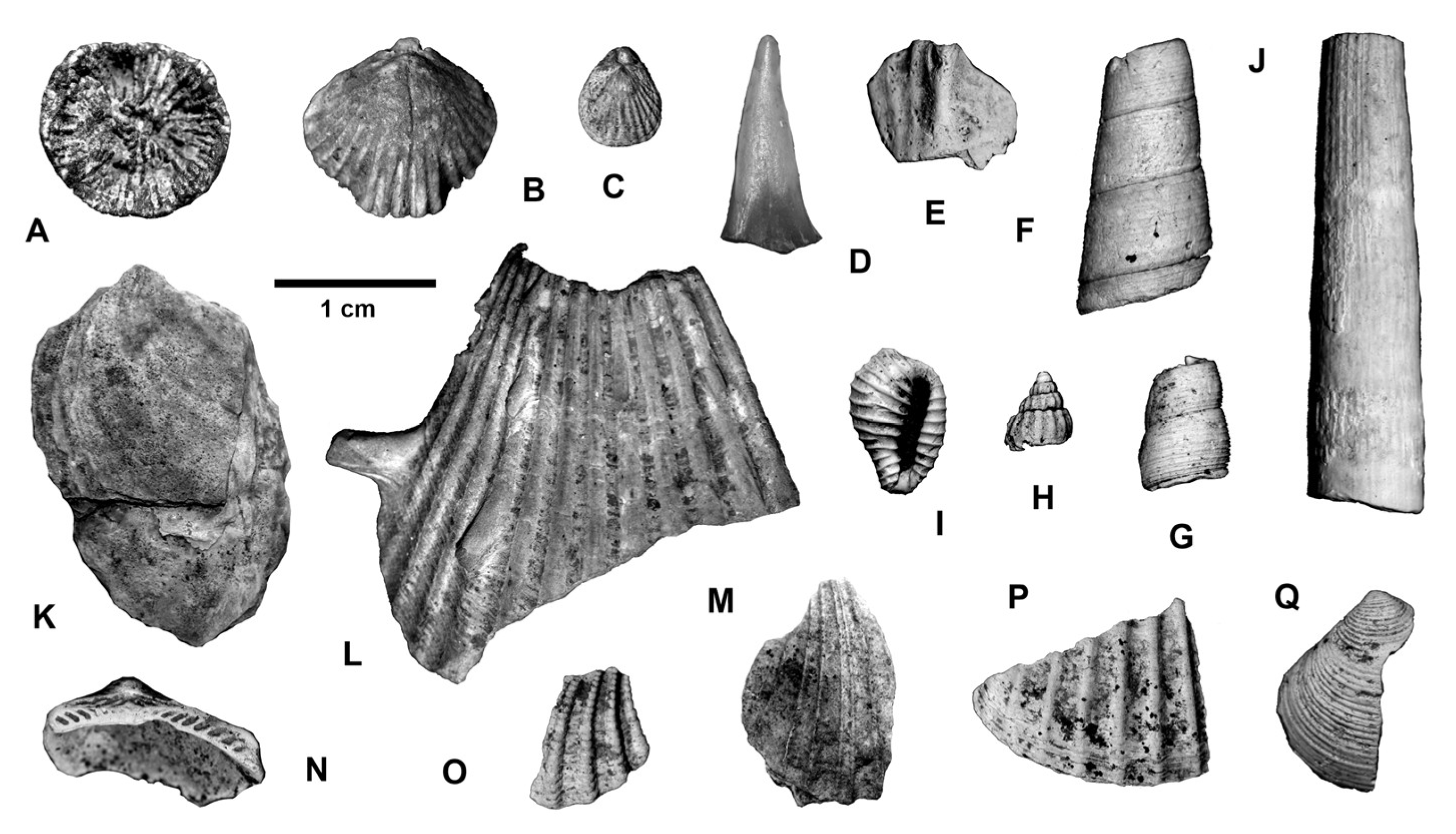
4. Fauna
4.1. Mollusks

4.2. Amphibians
4.3. Reptiles
4.4. Birds

4.5. Micromammals
4.6. Megamammals
4.7. Hyena Coprolites
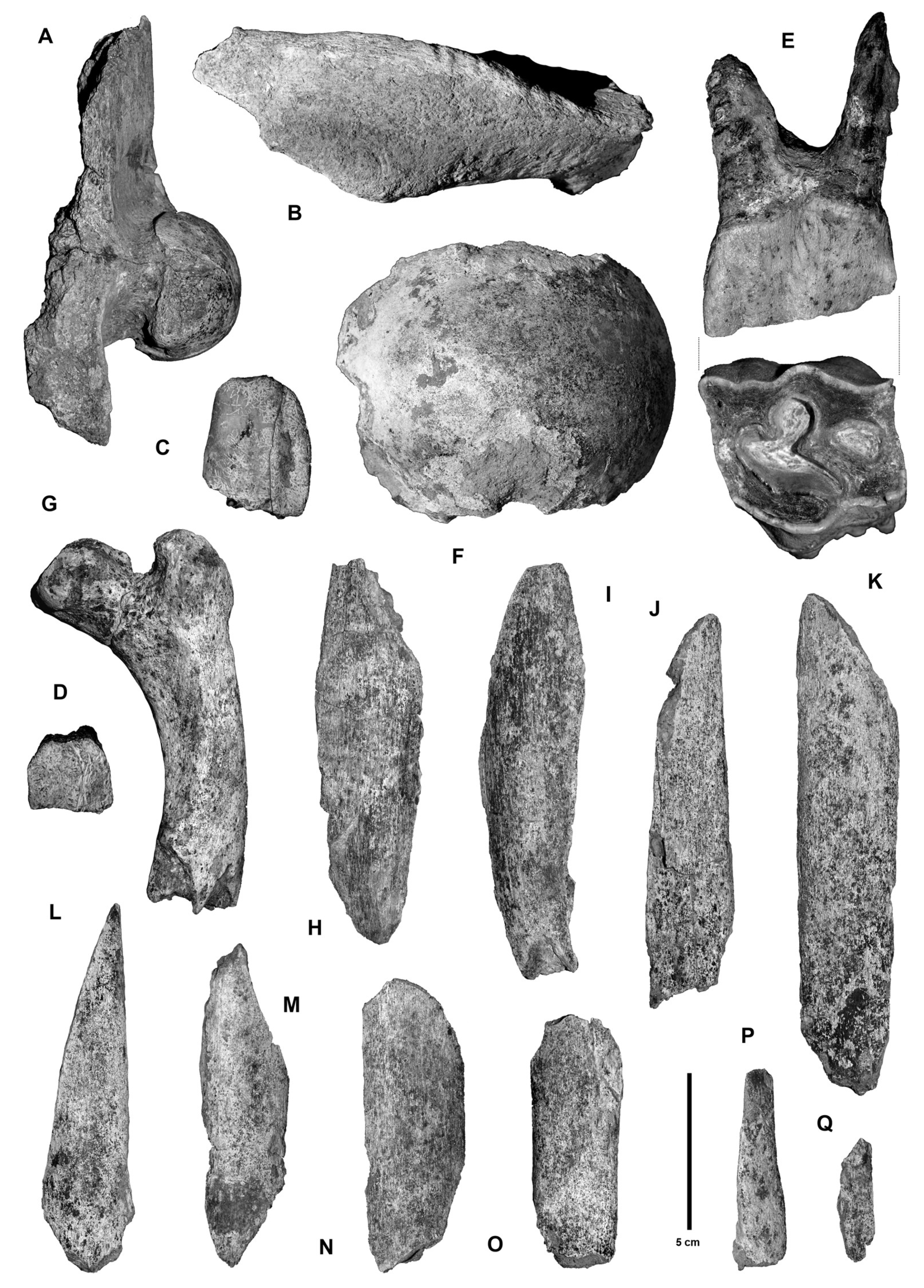
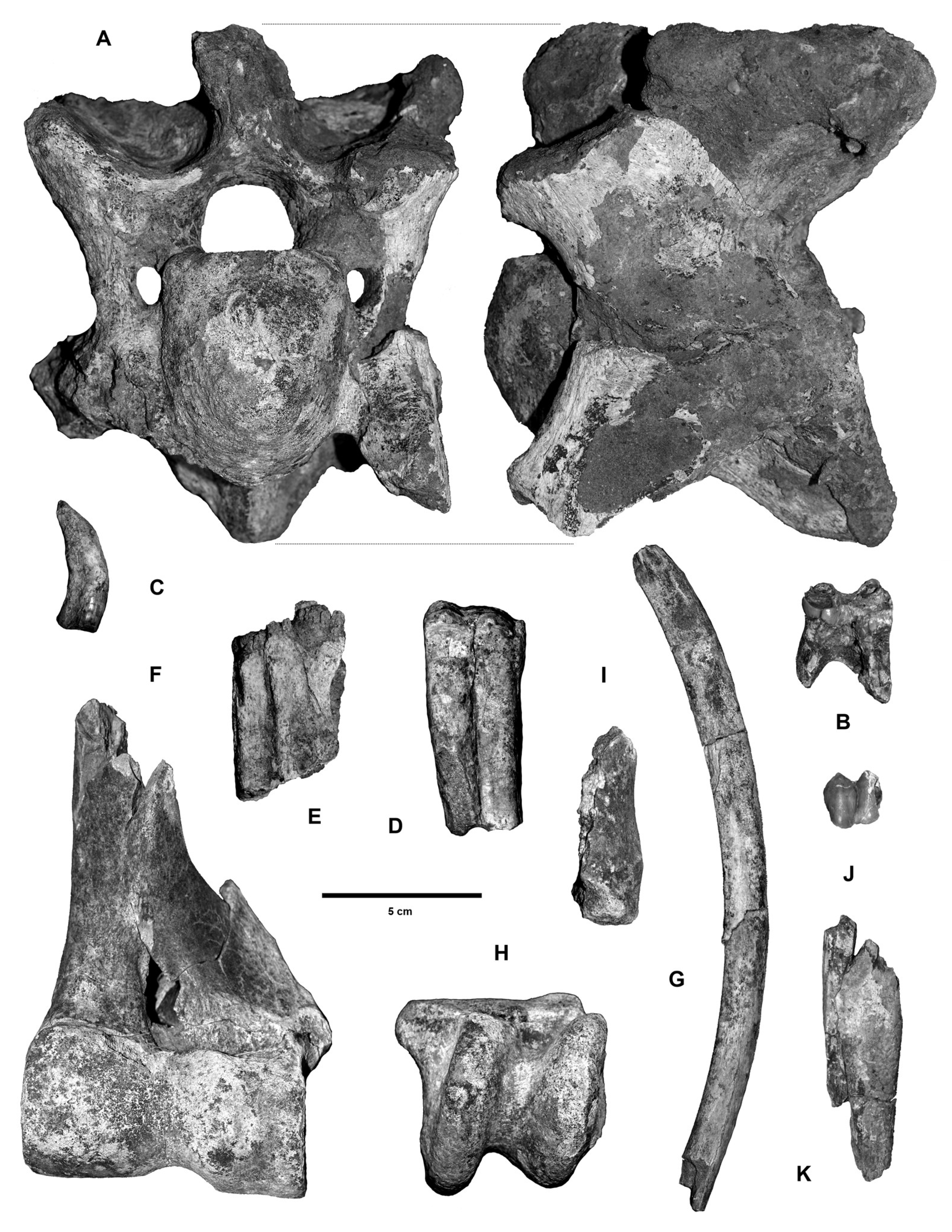
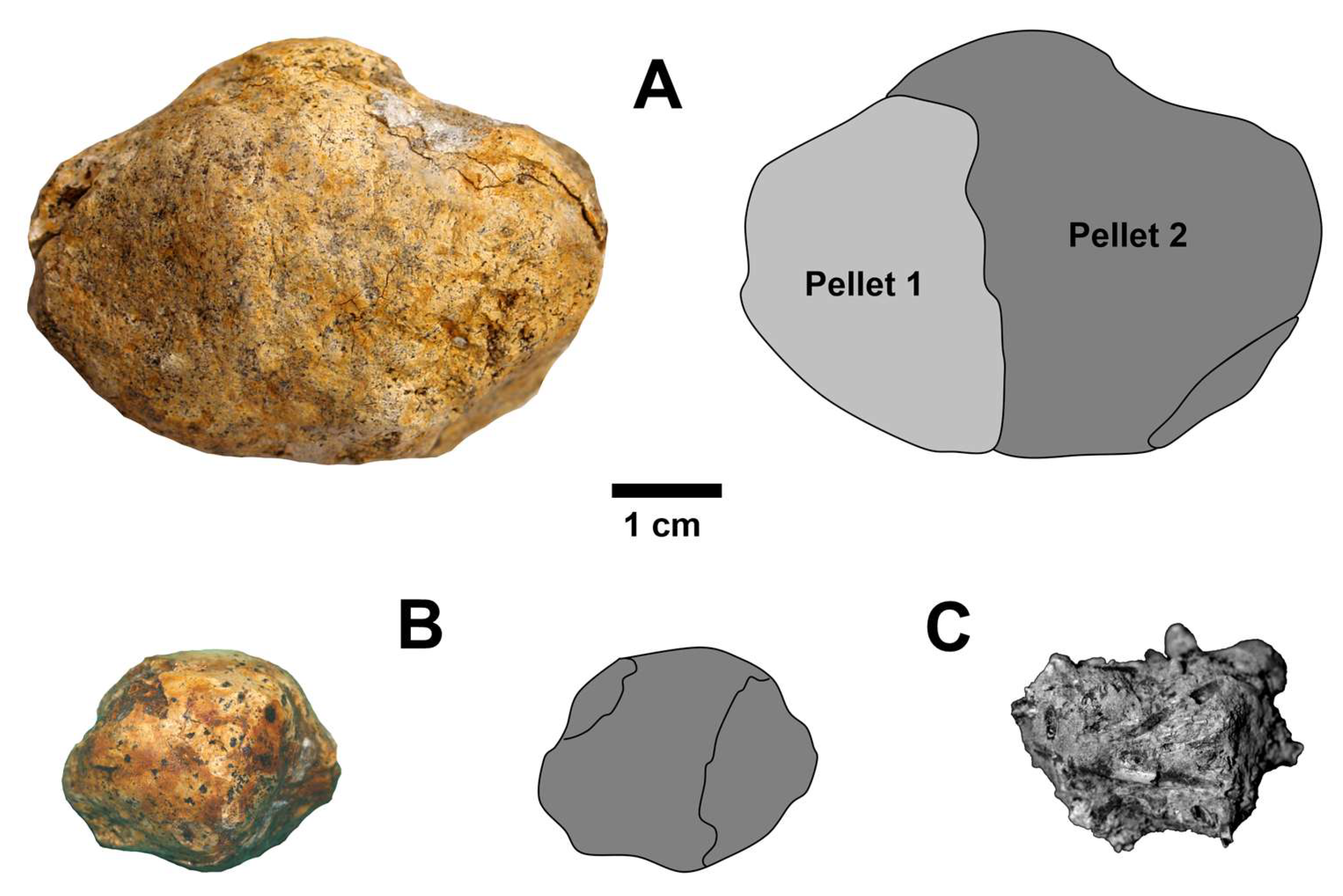
5. Middle Paleolithic Stone Artifacts
5.1. Stone Tool Raw Material
5.2. Artifact Distribution

5.3. Stone Tool Debris
5.4. Bifacial Stone Tools

6. Discussion
6.1. Sinkhole Sediment Filling History and Stratigraphy
6.2. C14 Dating
6.3. Mollusks as Paleoenvironmental Indicators
6.4. Micromammals as Paleoenvironmental Indicators
6.5. The Megafauna—Hyena Den Versus Human Import

6.6. Hyena Fecal Places Around Smashed Ribs
6.7. Artifacts

6.8. Seasonal Summer and Winter Camp Migration Model
7. Conclusions
Funding
Data Availability Statement
Acknowledgments
Conflicts of Interest
Correction Statement
Abbreviation
| LDA | Landesmuseum für ArchäologieSacchsen-Anhalt, Halle/Saale |
References
- Wächter, K. Geologische Exkursion in der Umgebung von Magdeburg; Kreisheimatmuseum d. Kreises Wanzleben: Wanzleben-Börde, Germany, 1965; Volume 3, pp. 1–120. [Google Scholar]
- Wächter, K. Der “Kalkberg” bei Westeregeln—Ein Geotop und Biotop von überregionaler Bedeutung. In Die alte Ziegelei Westeregeln, Ziethen Verlag, Oschersleben; Beaugrand, A., Ed.; Ziethen Verlag: Oschersleben, Germany, 2015; pp. 39–46. Available online: https://dr-ziethen-verlag.eshop.t-online.de/Beaugrand-Andreas-Die-alte-Ziegelei-Westeregeln-Geschichte-und-Geschichten-vom-Kalkberg (accessed on 20 August 2025).
- Beaugrand, A. (Ed.) Die Alte Ziegelei Westeregeln-Geschichte Und Geschichten Vom Kalkberg; Ziethen Verlag: Oschersleben, Germany, 2015; p. 552. Available online: https://museumsziegelei.de/das-buch-zur-alten-ziegelei-westeregeln/ (accessed on 20 August 2025).
- Diedrich, C. The Late Pleistocene Crocuta crocuta spelaea (Goldfuss, 1823) population and its prey from the gypsum karst den site Westeregeln near Magdeburg (Middle Germany). Abh. Ber. Naturk. Magdebg. 2007, 30, 57–83. [Google Scholar]
- Giebel, C.G. Mitteilungen über das Vorkommen der diluvialen Knochen in der Provinz Sachsen. Jb. Naturwiss. Ver. Halle/Saale 1850, 3, 12–21. [Google Scholar]
- Giebel, C.G. Beiträge zur Osteologie des Rhinoceros. Jb. Naturwiss. Ver. Halle/Saale 1850, 3, 72–157. [Google Scholar]
- Giebel, C.G. Die antediluvialianische Saeugethierfauna Deutschlands. Jb. Naturwiss. Ver. Halle/Saale 1852, 3, 219–236. [Google Scholar]
- Diedrich, C. IceAgeSafari in Central Europe—Last Rhinos; PaleoLogic Books: Taunusstein, Germany, 2025; p. 250. [Google Scholar]
- Virchow, R. Vorlage von Manufakten aus dem Diluvium von Thiede und Westregeln. Corresp. Dt. Ges. Anthr. Ethnogr. Urgesch. 1878, 11, 149–151. [Google Scholar]
- Nehring, A. Ausgrabungen diluvialer Tiere zu Westeregeln bei Oschersleben. Verh. Berl. Ges. Anthr. Ethnogr. Urgesch. 1875, 206–208. [Google Scholar]
- Nehring, A. Beiträge zur Diluvialfauna. Z. Dt. Ges. Naturw. 1876, 13/14, 1–60. [Google Scholar]
- Nehring, A. Die quaternären Faunen von Thiede und Westeregeln nebst Spuren des vorgeschichtlichen Menschen I. Archäol. Anthr. 1878, 10, 359–398. [Google Scholar]
- Nehring, A. Die quaternären Faunen von Thiede und Westeregeln nebst Spuren des vorgeschichtlichen Menschen II. Archäol. Anthr. 1878, 11, 1–24. [Google Scholar]
- Nehring, A. Fossile Pferde aus Deutschen Diluvial-Ablagerungen und ihre Beziehung zu den Lebenden Pferden; Hansebooks: Hamburg, Germany, 1884; pp. 81–160. [Google Scholar]
- Nehring, A. Übersicht über 24 mitteleuropäische Quartär-Faunen. Z. Dt. Geol. Ges. 1890, 32, 468–509. [Google Scholar]
- Toepfer, V. Westeregeln—Ein klassischer Fundplatz für die Forschungsgeschichte des mitteldeutschen Pleistozäns. Jahresschr. Mitteldt. Vorgesch. 1966, 50, 1–20. [Google Scholar]
- Heinrich, W.-D. Rodentier-Biostratigraphie und Altersstellung Pleistozäner Säugetier-Fundstätten Mitteldeutschlands. Veröff. Landes. Archäol. Sachs.-Anhalt. 2003, 57, 237–244. [Google Scholar]
- Diedrich, C. Late Pleistocene Crocuta crocuta spelaea (Goldfuss, 1823) clans as prezewalski horse hunters and woolly rhinoceros scavengers at the open air commuting den and contemporary Neanderthal camp site Westeregeln (central Germany). J. Archaeol. Sci. 2012, 39, 1749–1767. [Google Scholar] [CrossRef]
- Weber, T. Der Faustkeil—Das Universalgerät des Altsteinzeitmenschen? Kat. Dauerausst. Landesmus. Vorgesch. Halle 2004, 1, 167–174. [Google Scholar]
- Hoffmann, K.; Meyer, K.-D. Leitgeschiebezählungen von elster- und saalezeitlichen Ablagerungen aus Sachsen, Sachsen-Anhalt und dem östlichen Niedersachsen. Leipz. Geowiss 1997, 5, 115–128. [Google Scholar]
- Barsch, O. Erläuterungen zur Geologischen Karte von Preußen und Benachbarten Deutschen Ländern; Prussian Geological Institute: Berlin, Germany, 1923. [Google Scholar]
- Müller, A. Fauna und Paläoökologie des Marinen Mitteloligozäns der Leipziger Tieflandsbucht (Böhlener Schichten); Altenburg Natural Science Research: Altenburg, Germany, 1983; Volume 2, pp. 1–152. [Google Scholar]
- Diedrich, C. Palaeoecology of the macrofauna of the Upper Oligocene (Palaeogene) littoral to shallow subtidal of Astrup near Osnabrück (NW Germany). Centr. Eur. J. Geosci. 2011, 4, 163–187. [Google Scholar]
- Weber, T. Merkmalanalytische Untersuchungen an geschlagenen Steinartefakten. Landes. Archäol. Sach.-Anh. Landesmus. Vorgesch. 2003, 57, 647–658. [Google Scholar]
- Weber, T. The lower/middle Palaeolithic transition—Is there a Lower/Middle Palaeolithic transition? Preist. Apl. 2009, 44, 17–24. [Google Scholar]
- Weber, T. Bericht zur archäologischen Denkmalpflege im Regierungsbezirk Magdeburg. Archäol. Ber. Sachs.-Anh. 1994, 115–126. [Google Scholar]
- Brüning, H. Periglazial-Erscheinungenund Landschaftsgeneseim BereichdesmittlerenElbetalesbeiMagdeburg. Gött. Geogr. Abh. 1959, 23, 25–26. [Google Scholar]
- Glöer, P. Der Gefährdungsgrad der Sphaeriidae (Bivalvia, Veneroida) in Hamburg. Basteria 2006, 3, 29–37. [Google Scholar]
- Kerney, M.P.; Cameron, R.A.D.; Jungbluth, J. Die Landschnecken Nord-und Mitteleuropas; Parey-Verlag: Hamburg, Germany; Berlin, Germany, 1983; p. 384. [Google Scholar]
- Böhme, G. Zur Bestimmung Quartärer Anuren Europas an Hand von Skelettelementen. Wiss. Z. Humb.-Univ. Berl. Mathem.-Naturwiss. Reihe. 1977, 26, 283–300. [Google Scholar]
- Böhme, G. Die Äskulapnatter Elaphe longissima (Laurenti, 1768), ein mediterranes Faunenelement im Pleistozän und frühen Holozän Mitteleuropas. Praehist Thuring 2003, 9, 97–103. [Google Scholar]
- Diedrich, C. Porcupines in the Bohemian Karst—Excavation results of the first known Miocene Hystrix (Hystrix) parvae (Kretzoi, 1951) cave den in Central Europe. Scr. Facul. Sci. Univ. Masaryk. Geol. 2007, 35, 129–134. [Google Scholar]
- Blasius, W. Spermophilus rufescens Keys. and Blas. (der Örenburger Ziesel) fossil in Deutschland. Zool.-Bot. Ges. Osterr. 1882, 32, 60. [Google Scholar]
- Kafka, J. Recente und Fossile Nagethiere Böhmens; Fr. Řivnáč: Prague, Czech Republic, 1893; Volume 8, pp. 1–96. [Google Scholar]
- Feustel, R. Magdalénienstation Teufelsbrücke. II: Paläontologischer Teil; Thüringer Universitäts- und Landesbibliothek: Jena, Germany, 1980; Volume 3, pp. 1–71. [Google Scholar]
- Höck, C. Das Magdalènien der Kniegrotte—Ein Höhlenfundplatz bei Döbritz, Saale-Orla-Kreis; Thüringisches Landesamt für Denkmalpflege und Archäologie: Erfurt, Germany, 2000; Volume 35, pp. 1–241. [Google Scholar]
- Pickering, T.R. Reconsideration of criteria for differentiating faunal assemblages accumulated by hyenas and hominids. Int. J. Osteoarch. 2002, 12, 127–141. [Google Scholar] [CrossRef]
- Kuhn, B.F.; Berger, L.R.; Skinner, J.D. Examining criteria for identifying and differentiating fossil faunal assemblages accumulated by hyaenas. Int. J. Osteoarch. 2008, 20, 15–35. [Google Scholar] [CrossRef]
- Diedrich, C. The Crocuta crocuta spelaea (Goldfuss, 1823) population and its prey from the Late Pleistocene Teufelskammer Cave hyena den besides the famous Paleolithic Neanderthal Cave (NRW, NW Germany). Hist. Biol. 2011, 23, 237–270. [Google Scholar]
- Fosse, P.; Brugal, J.P.; Guadelli, J.L.; Michel, P.; Tournepiche, J.F. Les Repaires D‘ Hyenes des Cavernes en Europe Occidentale: Presentation et Comparisons de Quelques Assemblages Osseux. In Proceedings of the Economie Prehistorique: Les Comportements de Substance au Paleolithique, XVIII Rencontres Internationales d’Archéologie et d’Histoire d’Antibes “Économie préhistorique: Les Comportements de Subsistance au Paléolithique”, Antibes, France, 23–25 October 1997; pp. 43–61, ⟨halshs-00358921⟩. Available online: https://archivesic.ccsd.cnrs.fr/UNIV-GRENOBLE1/halshs-00358921 (accessed on 20 August 2025).
- Aldhouse-Green, S.; Scott, K.; Schwarcz, H.; Grün, R.; Housley, R.; Rae, A.; Bevins, R.; Redknap, M. Coygan Cave, Laugharne, 1995. South Wales, a Mousterian site and hyaena den: A report on the University of Cambridge excavations. Proc. Prehist. Soc. Lond. 1995, 61, 37–80. [Google Scholar] [CrossRef]
- Diedrich, C. Periodical use of the Balve Cave (NW Germany) as a Late Pleistocene Crocuta crocuta spelaea (Goldfuss, 1823) den: Hyena occupations and bone accumulations vs. human Middle Palaeolithic activity. Quat. Int. 2011, 233, 171–184. [Google Scholar] [CrossRef]
- Diedrich, C.; Žák, K. Late Pleistocene hyena Crocuta crocuta spelaea (Goldfuss, 1823) prey deposit and den sites in horizontal and vertical caves of the Bohemian Karst (Czech Republic). Bull. Geosci. 2006, 81, 237–276. [Google Scholar] [CrossRef]
- Diedrich, C. The Crocuta crocuta spelaea (Goldfuss, 1823) population from the early Late Pleistocene hyena freeland prey deposit site Biedensteg near Bad Wildungen (Hess, NW Germany) and contribution to their phylogenetic position, coprolites and prey. Cranium 2006, 23, 39–53. [Google Scholar]
- Diedrich, C. Specialized horse killers in Europe—Foetal horse remains in the Late Pleistocene Srbsko Chlum-Komín Cave hyena den in the Bohemian Karst (Czech Republic) and actualistic comparisons to modern African spotted hyenas as zebra hunters. Quat. Int. 2010, 220, 174–187. [Google Scholar] [CrossRef]
- Diedrich, C. By ice age spotted hyenas protracted, cracked, nibbled and chewed skeleton remains of Coelodonta antiquitatis (Blumenbach, 1807) from the Lower Weichselian (Upper Pleistocene) freeland prey deposit site Bad Wildungen-Biedensteg (Hessia, NW Germany). J. Taph. 2006, 4, 95–127. [Google Scholar]
- Diedrich, C. One of Europe’s last glacial Crocuta crocuta spelaea (Goldfuss, 1823) clans from the Rösenbeck Cave hyena den (Germany) and contribution to cranial shape variability. Biol. J. Linn. Soc. Lond. 2011, 103, 191–220. [Google Scholar] [CrossRef]
- Diedrich, C. The late Pleistocene spotted hyena Crocuta crocuta spelaea (Goldfuss 1823) population with its type specimens from the Zoolithen Cave at Gailenreuth (Bavaria, South Germany): A hyena cub raising den of specialised cave bear scavengers in boreal forest environments of Central Europe. Hist. Biol. 2011, 23, 335–367. [Google Scholar] [CrossRef]
- Diedrich, C. Zoolithen Cave (Germany)—Pleistocene Cave Bear/Hyena/Wolf Den, and Celtic Burial Site. In Famous Planet Earth Caves 3. PaleoLogic Books, Taunusstein; Independently published, 2025; p. 427. Available online: https://www.amazon.de/Famous-Planet-Earth-Zoolithen-Germany/dp/B0FCXT8NVW/ref=sr_1_3?dib=eyJ2IjoiMSJ9.g7upKft6hBDE_nunxsrVg7VGwPu30RePZ_jhVXbsCPTJSt3zpO4n5BptsqJqVRM0oMUMDUlxQuwG7WXixEI6uX_MZT6rnV5ZwO30aWH03Tvu2ZQ3T9mh-MRHANYLT6UDMAFO45Gnz2APYNJcoGFLKw.yrHGYWqTEiSzVpMZim8puySJwvAKDz5DbL_OB8TI9qc&dib_tag=se&qid=1758190320&refinements=p_27%3ACajus+Diedrich&s=books&sr=1-3 (accessed on 20 August 2025).
- Diedrich, C. Seltene Freilandfunde der späteiszeitlichen Fleckenhyäne Crocuta crocuta spelaea (Goldfuss 1823) in Sachsen-Anhalt und Beitrag zu Horsttypen der letzten Hyänen im Jung-Pleistozän von Mitteldeutschland. Z. Mitteldt. Vorgesch. 2014, 94, 1–19. [Google Scholar]
- Diedrich, C. Late Pleistocene spotted hyena den sites and specialized rhinoceros scavengers in the Thuringian Mountain Zechstein karst (Central Germany). Quat. Sci. J. 2015, 64, 29–45. [Google Scholar]
- Diedrich, C. Hermann’s Cave (Germany)—A Late Pleistocene Cave Bear Den. In Famous Planet Earth Caves 2; Bentham Science Publishers: Sharyahj, United Arab Emirates, 2017; p. 166. Available online: https://www.amazon.de/Hermanns-Cave-Germany-Pleistocene-English-ebook/dp/B077P4PJYX/ref=sr_1_10?dib=eyJ2IjoiMSJ9.g7upKft6hBDE_nunxsrVg7VGwPu30RePZ_jhVXbsCPTJSt3zpO4n5BptsqJqVRM0oMUMDUlxQuwG7WXixEI6uX_MZT6rnV5ZwO30aWH03Tvu2ZQ3T9mh-MRHANYLT6UDMAFO45Gnz2APYNJcoGFLKw.yrHGYWqTEiSzVpMZim8puySJwvAKDz5DbL_OB8TI9qc&dib_tag=se&qid=1758190320&refinements=p_27%3ACajus+Diedrich&s=books&sr=1-10 (accessed on 20 August 2025).
- Diedrich, C. Impact of the German Harz Mountain Weichselian ice-shield and valley glacier development onto Palaeolithics and megafauna disappearance. Quat. Sci. Rev. 2013, 82, 167–198. [Google Scholar] [CrossRef]
- Diedrich, C. Unicorn “holotype” skeleton from the Late Pleistocene spotted hyena den site Sewecken-Berge (Germany). Acta Zool. 2022, 104, 1–70. [Google Scholar] [CrossRef]
- Diedrich, C. The Late Pleistocene Crocuta crocuta spelaea (Goldfuss, 1823) population from the Emscher River terrace hyena open air den Bottrop and other sites in NW-Germany—Woolly rhinoceros scavengers and their bone accumulations along rivers in lowland mammoth steppe environments. Quat. Int. 2012, 276/277, 93–119. [Google Scholar]
- Bearder, S.K.; Randall, R.M. The use of fecal marking sites by spotted hyaenas and civets. Carnivore 1978, 1, 32–48. [Google Scholar]
- Weber, T. Die Steinartefakte des Homo erectus von Bilzingsleben. In Bilzingsleben III. Veröffentlichungen des Landesmuseums für Vorgeschichte in Halle; Weber, T., Mania, D., Eds.; Deutscher Verlag der Wissenschaften: Berlin, Germany, 1986; Volume 39, pp. 65–231. [Google Scholar]
- Schäfer, D.; Zöller, L. Zur Charakterisierung des weichselzeitlichen Fundhorizontes vom Gamsenberg bei Oppurg/Ostthüringen. Tübinger. Monogr. Urgesch. 1996, 11, 253–260. [Google Scholar]
- Mania, D.; Toepfer, V. Königsaue, Gliederung, Ökologie und mittelpaläolithische Funde der letzten Eiszeit; Landesmuseum für Vorgeschichte in Halle; Deutscher Verlag der Wissenschaften: Berlin, Germany, 1973; Volume 26, pp. 1–233. [Google Scholar]
- Jöris, O. Die aus der Kälte kamen. Von der Kultur später Neandertaler in Mitteleuropa. Mitt. Ges. Urgesch. 2002, 11, 5–30. [Google Scholar]
- Jöris, O. Zur chronostratigraphischen Stellung der spätmittelpaläolithischen Keilmessergruppen. Der Versuch einer kulturgeographischen Abgrenzung einer mittelpaläolithischen Formengruppe in ihrem europäischen Kontext. Ber. Röm.-Germ. Komiss. 2004, 84, 49–154. [Google Scholar]
- Brühl, E.; Laurat, T. The Middle Palaeolithic at the Geisel Valley—Recent excavations at the fossil lake Neumark-Nord2 (Sachsen-Anhalt, Germany). Acta Univ. Wratislav. 2010, 3207, 1–36. [Google Scholar]
- Soressi, M. Die Steintechnologie des Spätmoustérien. Ihre Bedeutung für die Entstehungsgeschwindigkeit modernen Verhaltens und die Beziehung zwischen modernem Verhalten und biologischer Modernität. Mitt. Ges. Urgesch. 2004, 13, 9–28. [Google Scholar]
- Wynn, T.; Tierson, T. Regional comparison of the shapes of later Acheulean handaxes. Amer. Anthr. 2009, 92, 73–84. [Google Scholar]
- Camps, M.; Chauhan, P. Sourcebook of Paleolithic Transitions; Springer: New York, NY, USA, 2009; p. 573. [Google Scholar]
- Iovita, R.; McPherron, S.P. The handaxe reloaded: A morphometric reassessment of Acheulian and Middle Paleolithic handaxes. J. Hum. Evol. 2011, 61, 61–74. [Google Scholar] [CrossRef]
- Binford, L. Willow Smoke and Dog’s Tails: Hunter-Gatherer settlement systems and Archaeological sites formation. Amer. Antiq. 1980, 45, 4–20. [Google Scholar] [CrossRef]
- Andrefsky, W. Lithics. Macroscopic Approaches to Analysis; Cambridge University Press: Cambridge, UK, 1998; p. 326. [Google Scholar]
- Gaudzinski, S.; Roebroks, W. Adults only. Reindeer hunting at the Middle Palaeolithic site Salzgitter Lebenstedt, Northern Germany. J. Hum. Evol. 2000, 38, 497–521. [Google Scholar] [CrossRef]
- Van Kolfschoten, T.; Buhrs, E.; Verheijen, I. The larger mammal fauna from the Lower Paleolithic Schöningen spear site and its contribution to hominin subsistence. J. Hum. Evol. 2015, 89, 138–153. [Google Scholar] [CrossRef]
- Hutson, J.M.; Bittmann, F.; Fischer, P.; García-Moreno, A.; Gaudzinski-Windheuser, S.; Nelson, E.; Ortiz, J.E.; Penkman, K.E.H.; Perić, Z.M.; Richter, D.; et al. Revised age for Schöningen hunting spears indicates intensification of Neanderthal cooperative behavior around 200,000 years ago. Sci. Adv. 2025, 11, eadv0752. [Google Scholar] [CrossRef]
- Musil, R. Die Pferde von Schöningen: Skelettreste einer ganzen Wildpferdherde. In Die Schöninger Speere—Mensch und Jagd vor 400,000 Jahren; Thieme, H., Ed.; VML Vlg Marie Leidorf: Rahden, Germany, 2007; pp. 136–140. [Google Scholar]
- Voormolen, B. Ancient Hunters, Modern Butcher Schöningen 13II-4, a Kill-Butchery Site Dating from the Northwest European Lower Palaeolithic. Ph.D. Thesis, University Leiden, Leiden, The Netherlands, 2008; p. 145. [Google Scholar]
- Ruebens, K.; Smith, G.M.; Fewlass, H.; Inet-Mathiot, V.; Hublin, J.-J.; Welker, F. Neanderthal subsistence, taphonomy and chronology at Salzgitter-Lebenstedt (Germany): A multifaceted analysis of morphologically unidentifiable bone. J. Quat. Sci. 2023, 38, 471–487. [Google Scholar] [CrossRef]
- Ludowici, B.; Pöppelmann, H. Die Tierknochenfunde der Mittelpaläolithischen Jägerstation von Salzgitter-Lebenstedt; Verlag Uwe Krebs: Wendeburg, Germany, 2018; Volume 1, pp. 1–304. [Google Scholar]
| Species | NISP |
|---|---|
| Mammuthus primigenius | 11 |
| Coelodonta antiquitatis antiquitatis | 6 |
| Bison priscus | 5 |
| Equus ferus cf. przewalskii | 12 |
| Rangifer tarandus | 3 |
| Martes sp. | 2 |
| Micromammals | 200 |
| Birds | 10 |
| Snakes | 65 |
| Anures | 45 |
Disclaimer/Publisher’s Note: The statements, opinions and data contained in all publications are solely those of the individual author(s) and contributor(s) and not of MDPI and/or the editor(s). MDPI and/or the editor(s) disclaim responsibility for any injury to people or property resulting from any ideas, methods, instructions or products referred to in the content. |
© 2025 by the author. Licensee MDPI, Basel, Switzerland. This article is an open access article distributed under the terms and conditions of the Creative Commons Attribution (CC BY) license (https://creativecommons.org/licenses/by/4.0/).
Share and Cite
Diedrich, C.G. Middle Paleolithic Neanderthal Open-Air Camp and Hyena Den Westeregeln (D)—Competition for Prey in a Mammoth Steppe Environment of Northern Germany (Central Europe). Quaternary 2025, 8, 52. https://doi.org/10.3390/quat8040052
Diedrich CG. Middle Paleolithic Neanderthal Open-Air Camp and Hyena Den Westeregeln (D)—Competition for Prey in a Mammoth Steppe Environment of Northern Germany (Central Europe). Quaternary. 2025; 8(4):52. https://doi.org/10.3390/quat8040052
Chicago/Turabian StyleDiedrich, Cajus G. 2025. "Middle Paleolithic Neanderthal Open-Air Camp and Hyena Den Westeregeln (D)—Competition for Prey in a Mammoth Steppe Environment of Northern Germany (Central Europe)" Quaternary 8, no. 4: 52. https://doi.org/10.3390/quat8040052
APA StyleDiedrich, C. G. (2025). Middle Paleolithic Neanderthal Open-Air Camp and Hyena Den Westeregeln (D)—Competition for Prey in a Mammoth Steppe Environment of Northern Germany (Central Europe). Quaternary, 8(4), 52. https://doi.org/10.3390/quat8040052






